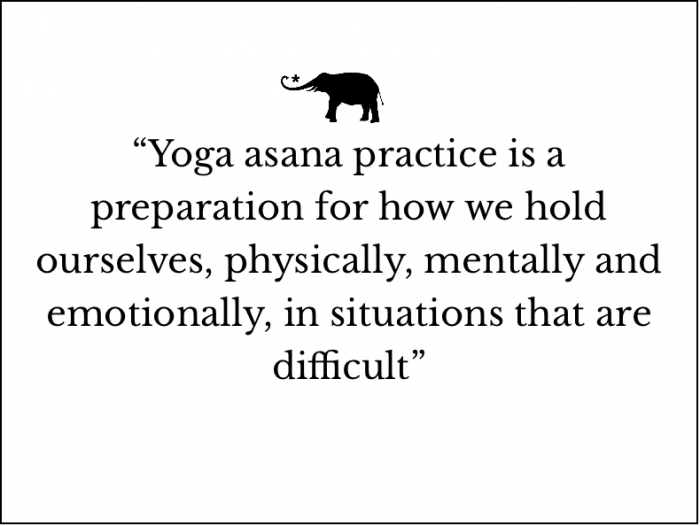~
More than a year ago, when the closing of my studio was imminent, my yoga practice was truly tested.
Handstands and legs behind the head were simple compared to what was about to take place.
Thank goodness for my love of retreat and solitude. That part was easy. It was the physical breakup of the community that was most saddening. It has affected us all in ways we may not ever have imagined.
Politics, medicine, media, and even history have come into question. Our own families may be widely polarized on current issues. Who are we and where are we going as a culture, as a country, as individuals?
I had to deeply dig into myself for inspiration, strength, and perseverance. I wanted to curl up on the couch, hide, and watch Netflix—which I did do, but that wasn’t going to feed my daughter or save my business.
Where would I draw my strength and how would I get grounded again when everything went topsy-turvy?
In cleaning the house, or rather, digging through old stuff because, what else was there to do in lockdown, I stumbled upon an article in the Patriot News (a local Pennsylvania newspaper) about my Great Grandma Stroh. (Side note: The Patriot News had a section highlighting strong women in 1972?)
Great Grandma married a man 20-plus-years her senior. He passed, away leaving her with three children and a huge farm to maintain. She had no option but to carry on and feed her family. She dug in her stubborn heels and raised high-quality strawberries and flowers to sell at the market—thereby saving the family’s 200-acre farm for her children, their children, and ultimately, for my daughters and me.
She lived on the land that the Stroh family was granted in the 1700s. They had fought in the Revolutionary War after having immigrated here from Germany. Great Grandma Stroh left a legacy of perseverance and a certain stoicism that became a trait in my family. She wasn’t blood, but her lineage was just as deeply rooted and strong. She had to carry on, and she did. Great Grandma Stroh lived to be 99 years old and had her wits about her to the end.
As a hobby, in her golden years, she took up genealogy. She had a habit of doing most things thoroughly. So, what did she leave as part of her legacy? She left a detailed genealogy that traced my Stroh roots right back to Germany.
She sustained and preserved our roots.
I had to dig in my heels and get myself grounded. I drew inspiration from my own history, strengthened myself for the long haul, and fertilized my roots in the community.
I found camaraderie in local business owners who may have otherwise been competitors. I watched the news and questioned everything. I balanced myself in the extremism and stoically hushed the noises in my head. (Yes, I learned that through years of yoga.) I remembered my ancestors and how they worked the land to raise the crops to feed the future which was now my business and mine and my daughter’s sustenance. I suddenly craved strawberries and fresh flowers!
What does this all have to do with yoga?
Yoga comes from the Sanskrit word “yug” which can mean a host of things depending on its context. It is most often associated with words like “hitching, yoking, binding, or union.” The first historical use of the word relates back to hitching a horse or animal to a cart. In a spiritual sense, we might think of Yoga as a hitching up of one’s spirit with a higher power. The postures are vehicles, or our body’s “cart,” to position solidly in the ground, rooting down in order to rise up to meet our potential.
The posture held now, in the midst of this pandemic, is the one my yoga practice has prepared me to hold. Patanjali’s Yoga Sutras, often referred to as a classical yogic text, says “Shtira sukaham asanam” (or Asana ) is to be held with steadiness and ease. My Great Grandma knew the importance of steadiness and ease without ever being aware of the Yoga Sutras.
Dig deep and hold steady and find the ease in the holding.
How I hold steady now is for my daughter and her children in perpetuity and “pandemikasana” (pandemic-asana) can now be added to the postural lineage.
How to practice pandemikasana:
>> Wake up in the morning and think of how lucky you are that you woke up.
>> Notice your feet and how you walk—thank goodness you are able to walk today.
>> Notice your hands or your jaw. Are they clenched? Pause. Breath and relax where you don’t need to clench. Be gentle with yourself if you can’t relax right away.
>> How is your spine being held while you work or go to the grocery store having to remember to wear your mask? Stand tall, root into your feet, and be patient with those who wear or don’t wear their masks. Remember, you don’t know their story and you don’t control them.
>> Are you breathing or holding your breath while waiting for the next breaking news story? Breath freely and remember what is in your control and what is not.
Five benefits of pandemikasana:
1. Increases the value of life for all beings.
2. Teaches mindfulness in the midst of madness and patience for one’s own crap and others’.
3. Stimulates creativity and inner reflection.
4. Reduces competition and increases cooperation.
5. Connects us to all humanity.
Yoga asana practice is a preparation for how we hold ourselves—physically, mentally, and emotionally—in situations that are difficult.
Nurture your roots and stay grounded.
If you have a family that inspires you, look past their failings. Set your Drishti, your gaze, on what they did right—what they did to get you to where you are now and honor them for fertilizing the ground, however stinky it may have been, on which you are able to sustain your roots.
~









Read 0 comments and reply